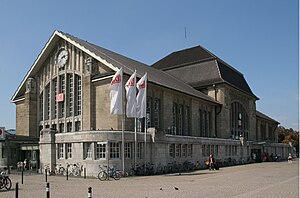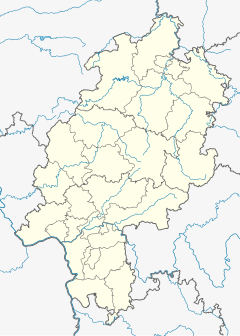Darmstadt Hauptbahnhof
Darmstadt Hauptbahnhof is the main railway station in the German city Darmstadt. After Frankfurt Hbf and Wiesbaden Hbf, it is the third largest station in the state of Hesse with 35,000 passengers and 220 trains per day.
Built in a late Art Nouveau style, the station was finished 1912 as one of the major works of architect Friedrich Pützer.[5] The station replaced two separate and increasingly inadequate stations located at the Steubenplatz, around a km closer to the city centre in the east.
History
[edit]The predecessors of Darmstadt Hauptbahnhof were two separate stations in today's Steubenplatz, which were built by two railway companies in the 19th century when Darmstadt was connected to the rail network: the Main-Neckar station, a through station on the Frankfurt–Heidelberg line, opened in 1846, and the Ludwig station, a terminal station on the Mainz–Aschaffenburg railway, opened in 1858.
The space at both stations became very cramped as a result of the increase in traffic at the end of the 19th century. Due to urban growth in Darmstadt, all space at the stations had been used, so that the necessary extensions of the old sites were not possible and the separation into two stations made operations difficult and road traffic on the level crossing of the Main-Neckar Railway over Rheinstraße created an obstruction to traffic.
Planning
[edit]
Beginning in 1901 four different designs were developed, focused primarily on a solving the problems of managing traffic, and subsequently discarded. In 1905, the city and the Prussian-Hessian Railway division in Mainz finally agreed on a fifth draft. It stipulated that a new through station would be built on a then green-field site about 800 metres west of the old stations. The greater distance from the city centre would be compensated by providing a connecting tram. The post office would have its own railway post office north of the entrance building, connected by the "Post Bridge" (Poststeg), its own covered bridge, to trains at the mail and baggage platforms below it. The Post Bridge was demolished in 1994.[6]
The tracks in the southern part of the station precinct were placed in a cutting so that the streets could be built over it. The same was true of the station building: passengers enter the station building at street level, pass through the station on the same level and reach the platforms by stairs from an overpass (for some years there have also been lifts). Parallel to this there was a separate overpass for luggage and the express freight service (this was converted in the last renovation into a bicycle parking garage). The northern tracks of the station precinct are on an embankment as the station site slopes down to the north.
An architectural competition was announced for the construction of the station building. At the express request of Grand Duke Ernst Ludwig, the new station would be built by a modern master builder (Baumeister), not a style architect (Stilarchitekten).[7] Kaiser Wilhelm II refrained for diplomatic reasons from intervening on the issue, although he intervened in the design of many other station buildings on the Prussian state railways.
A total of 75 designs were submitted. Friedrich Pützer and Friedrich Klingholz each received a second prize. The contract was awarded in 1908 to Friedrich Pützer. It took him two years to complete his designs, into which he also incorporated some good ideas from the designs of his competitors.
Construction began in 1906 and was completed in 1912 at a total cost of 17 million marks. At that time, the experts made a fairly cautious judgements about the new building: "it has some very efficient services, but no great ideas." Today the building is regarded as groundbreaking and it is protected as a monument.
A water tower was built at the Dornheimer Weg bridge to supply the locomotives with water in 1910. This building, which was set to be demolished in 1978, is also now under monument protection.
Architecture of the entrance building
[edit]The station represents the traditionalist architecture of Pützer, as was typical for railway buildings at the time. The design elements on the facade and the interior are reminiscent of the then fashionable Art Nouveau style.
The station building was renovated from 1998 to 2002, requiring intensive conservation. The 94 metres long and 34 metres wide platform area has ten platform tracks and was renewed in 2005–2008 for approximately €31 million.[8] Lifts were installed on the passenger overpass over the platforms to connect with the platforms below, supplementing the stairs, so that the station was accessible for the handicapped for the first time. The elevated platform overpass was extended to accommodate a shopping centre in 2000 with finance from the city of Darmstadt; this also allows access to the district to the west, which is the location of the seat of the European Space Operations Centre, among other things.
A special feature is the so-called Fürstenbahnhof (“princely station”) in the south of the station building, which has since developed into a facility for public transport. It had the usual waiting rooms for this purpose, sanitary facilities, a spacious driveway and its own entrance to platform 1, the princely platform. Its solid wall with numerous Art Nouveau features is largely preserved. The former Bahnpolizei (railway police) were located here before the last renovation of the entrance building. In mid-2010, the Fürstenbahnhof restaurant was opened to the public in the princely station.
In 1972, the former twelve signal boxes were replaced by a modern signal control centre.
Rail services
[edit]Long-distance
[edit]The station is on the long-distance network of Deutsche Bahn, although the majority of traffic on the north–south long-distance routes runs on the Mannheim–Frankfurt railway. Several Intercity and Intercity-Express lines connect the city directly to Karlsruhe, Stralsund (via Hanover and Hamburg) and Salzburg (via Stuttgart and Munich).[9]
| Line | Route | Frequency |
|---|---|---|
| ICE 4 | Hamburg-Altona – Hamburg – Hannover – Frankfurt – Darmstadt | One train (Mon–Fr) |
| ICE 15 | (Binz – Pasewalk –) Berlin – Halle – Erfurt – Frankfurt – Darmstadt (– Heidelberg – Stuttgart) / (– Mannheim – Kaiserslautern – Saarbrücken) | Individual services |
| ICE 26 | Stralsund – Hamburg – Kassel-Wilhelmshöhe – Gießen – Frankfurt – Darmstadt – Heidelberg – Karlsruhe | Every 2 hours |
| EC/RJX 32 | Frankfurt – Darmstadt – Bensheim – Weinheim – Heidelberg – Stuttgart – Ulm – Friedrichshafen – Lindau-Reutin – Innsbruck – Salzburg – Vienna – Vienna Airport | 1 train pair |
| ICE 41 | Darmstadt – Frankfurt – Frankfurt Airport – Köln Messe/Deutz – Düsseldorf – Duisburg – Essen – Dortmund – Paderborn – Kassel-Wilhelmshöhe – Fulda – Würzburg – Nuremberg – Munich | Single service |
| ICE 62 | Frankfurt – Darmstadt – Stuttgart – Munich – Salzburg – Graz / Klagenfurt | 4 train pairs |
| IC 87 | Frankfurt – Heidelberg – Stuttgart – Singen | Individual services |
| FLX 10 | Berlin Hbf – Berlin Südkreuz – Halle (Saale) – Erfurt – Gotha – Eisenach – Fulda – Frankfurt South – Darmstadt – Heidelberg – Stuttgart | 1–2 train pairs |
An ICE Sprinter also operates in the morning from Darmstadt to Berlin via Frankfurt.
Regional services
[edit]Darmstadt station has been served by the Rhine-Main S-Bahn since 1997, originally by lines S3 and S4 and from December 2024 by line S6. Other regional connections are available to Frankfurt via (Langen), Wiesbaden (via Groß-Gerau and Mainz), Aschaffenburg (via Dieburg and Babenhausen), Mannheim and Heidelberg (via Bensheim and Weinheim) and Eberbach (via Groß-Umstadt Wiebelsbach). The lines to Riedstadt-Goddelau (via Griesheim) and Groß-Zimmern (via Roßdorf), on the other hand, have been closed for a long time. The Pfungstadt Railway (Pfungstadtbahn) to Pfungstadt was reactivated at the beginning of the 2011/2012 timetable on 11 December 2011. It is served by the extension of services on the Odenwald Railway (Odenwaldbahn) from Darmstadt station to Pfungstadt as RB 66.
| Line | Route | Frequency |
|---|---|---|
| RE 60 | Frankfurt – Darmstadt – Bensheim – Heppenheim – Weinheim – Mannheim | Hourly |
| RE 80 | Darmstadt – Darmstadt Nord – Reinheim – Groß-Umstadt Wiebelsbach – Erbach | Every two hours (Mon–Fri) |
| RB 66 | Darmstadt – Darmstadt-Eberstadt – Pfungstadt | Hourly (Mon–Sat) Every two hours (Sun) |
| RB 67 | Frankfurt – Darmstadt – Bensheim – Heppenheim – Weinheim – Neu-Edingen/Friedrichsfeld – Mannheim/Schwetzingen | Hourly (alternating between Mannheim and Schwetzingen) |
| RB 68 | Frankfurt – Darmstadt – Bensheim – Heppenheim – Weinheim – Neu-Edingen/Friedrichsfeld – Heidelberg – Wiesloch-Walldorf | Hourly |
| RB 75 | Wiesbaden – Mainz – Groß Gerau – Darmstadt – Dieburg – Babenhausen – Aschaffenburg | Hourly Every half hour (Mon–Fri; Sat Wiesbaden–Darmstadt) |
| RB 81 | Darmstadt – Darmstadt Nord – Reinheim – Groß-Umstadt Wiebelsbach – Erbach – Eberbach | Every two hours |
| Friedberg (Hess) – Bad Vilbel – Frankfurt West – Frankfurt – Frankfurt Süd – Langen – Darmstadt | Every half hour[10] |
Other public transport
[edit]The station is connected by trams and buses to the urban transport network and served by regional bus lines. There is also a direct bus to Frankfurt Airport.[11] Darmstadt Hauptbahnhof is just east of the city's major roads: Autobahnen (Bundesautobahn 5 and Bundesautobahn 67). Darmstadt Hauptbahnhof is on the main west–east road the Bundesstraße 26. A few blocks away is the main north–south road the Bundesstraße 3.
See also
[edit]References
[edit]Footnotes
[edit]- ^ a b "Stationspreisliste 2025" [Station price list 2025] (PDF) (in German). DB Station&Service. 28 November 2024. Retrieved 5 December 2024.
- ^ Eisenbahnatlas Deutschland (German railway atlas) (2009/2010 ed.). Schweers + Wall. 2009. ISBN 978-3-89494-139-0.
- ^ "Tarifinformationen 2021" (PDF). Rhein-Main-Verkehrsverbund. 1 January 2021. p. 133. Archived from the original (PDF) on 15 May 2021. Retrieved 8 April 2021.
- ^ "Ein Parkhaus fürs Fahrrad". Frankfurter Rundschau (in German). Archived from the original on 14 June 2010. Retrieved 5 May 2012.
- ^ "Darmstadt – Hauptbahnhof und Mathildenhöhe" (in German). Retrieved 4 May 2012 (excursion details for Wednesday 19 June 2002, from a conference of the Department for Heritage Protection, Hesse.
{{cite web}}: CS1 maint: postscript (link) - ^ Annette Wannemacher (6 May 1994). "Keine Rettung für den Poststeg". Darmstädter Echo (in German).
- ^ Bernd Kimmel. Joseph M. Olbrich 1867–1908 (in German). p. 264 (Mathildenhöhe 18 September – 27 November 1983, exhibition catalogue)
{{cite book}}: CS1 maint: postscript (link) - ^ "Erneuerung Hallendach Hauptbahnhof Darmstadt" (in German). Ed. Züblin AG. Archived from the original on 4 March 2016. Retrieved 4 May 2012.
- ^ "Web-Bahnhofstafel". iris.noncd.db.de (in German). Retrieved 1 February 2023.
- ^ Fromm, Marie-Cathérine (19 November 2024). "S-Bahn-Netz in Rhein-Main wird neu sortiert" [S-Bahn network in Rhine-Main will be reorganised]. Hessenschau (in German). Retrieved 16 December 2014.
- ^ "HEAG AirLiner timetable 2015" (PDF) (in German). Archived from the original (PDF) on 4 March 2016. Retrieved 27 Aug 2015.
Sources
[edit]- "Wettbewerb für Vorentwürfe zum Empfangsgebäude auf dem neuen Hauptbahnhof in Darmstadt" (PDF). Zentralblatt der Bauverwaltung (in German). Berlin: 118–120. 29 February 1908.
- Heinz Schomann (2005). Landesamt für Denkmalpflege Hessen (ed.). Kulturdenkmäler in Hessen. Eisenbahn in Hessen. Kulturdenkmäler in Hessen. Denkmaltopographie Bundesrepublik Deutschland (in German). Vol. 2.1: Eisenbahnbauten und -strecken 1839–1939. Stuttgart: Theiss Verlag. pp. 62ff. ISBN 3-8062-1917-6.
- Heinz Schomann (1994). Landesamt für Denkmalpflege Hessen (ed.). Stadt Darmstadt. Kulturdenkmäler in Hessen. Denkmaltopographie Bundesrepublik Deutschland (in German). Braunschweig: Friedr. Vieweg & Sohn Verlagsges. pp. 562ff. ISBN 3-528-06249-5.
- Angelika Nold, ed. (1976). "Das Empfangsgebäude des Hauptbahnhofs in Darmstadt. Ein Phyrrhussieg des Jugendstils". Hessische Heimat (in German). 26 (4): 115–125.
External links
[edit]- "Track plan of Darmstadt Hbf" (PDF; 259.2 KB) (in German). Deutsche Bahn. Retrieved 4 May 2012.
- "(Old) photographs of Darmstadt Hauptbahnhof" (in German). Retrieved 4 May 2012.
- "Information about tram connections to central Darmstadt" (PDF) (in German). DADINA. Archived from the original (PDF-Datei; 315 kB) on 18 April 2013. Retrieved 4 May 2012.










